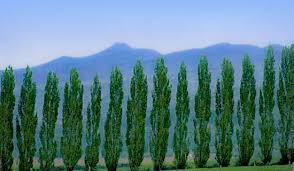 The house where I grew up was sold to another family right after I got married, so my memories of the place have grown rosy-tinted over time. One thing is certain. The back garden was bounded by eight tall Lombardy poplar trees. My father loved them and they were everywhere in my hometown. Now they have gone the way of the elm and the American chestnut. More of them linger in old photos than in modern landscapes.
The house where I grew up was sold to another family right after I got married, so my memories of the place have grown rosy-tinted over time. One thing is certain. The back garden was bounded by eight tall Lombardy poplar trees. My father loved them and they were everywhere in my hometown. Now they have gone the way of the elm and the American chestnut. More of them linger in old photos than in modern landscapes.
A mature Lombardy poplar grows 40 to 50 feet tall, but the columnar form means that its spread is only about 10 to 15 feet. As the variety name suggests, the trees stand like punctuation points in the landscape, and have long been used as borders or to flank driveways or roads. The trees are deciduous, but the green leaves turn an attractive buttery yellow in the fall before disappearing for the winter. The impressive upright structure remains stark and beautiful during the cold months.
Lombardy poplar or Populus nigra ‘Italica’ is descended from trees native to Europe, North Africa and Russia. The species’ origins are somewhat murky, but it may have appeared in the Lombardy region of Italy as early as the 1600’s as a natural mutation of the black poplar. As a member of the useful, incredibly hardy and large willow or Salix family, it would have been very easy to propagate from cuttings, which may account for its quick spread through Europe and ultimate, to America.
Lombardies are sometimes called “Mormon poplar” or “Mormon tree” because Mormon settlers planted them as windbreaks and boundary markers as they moved west in the mid-nineteenth century. Author Wallace Stegner noted this in his elegiac 1942 book Mormon Country.
The Mormons and generations of Americans through the nineteen fifties and sixties loved the fact that Lombardies grew at an amazing rate. They were equally useful as shade trees and windbreaks for early farmsteads, as well as being appropriate complements to the Italian villa-style houses that were popular as the nineteenth century turned to the twentieth. Later on, the trees’ rapid growth contributed a sense of nearly-instant permanence to the fast growing suburbs of mid-century America. Landscapers used them so much that they became ubiquitous.
In spite of that rampant popularity, very few Lombardies dot the American landscape now.
Why did they disappear? They did not suffer the fate of chestnuts and elms, dying out en masse from a single disease or blight. They were, however, subject to a number of flaws that led to a precipitous decline in popularity.
The flip side of the Lombardy’s fast-growing nature is that the trees are short-lived; dying within 30 or 40 years of planting—if they don’t succumb to aphids, borers or canker before that. The wood is weak and easily broken in storms. Like so many willow family members, Lombardies are shallow-rooted and prone to forming root suckers easily. Those roots and suckers mean they are likely to uproot sidewalks, infiltrate pipes, interfere with lawn maintenance, and cause other mayhem in home landscapes.
They also dislike hot sticky summer weather, so prevalent in many parts of the United States.
Poplars in general are often called “cottonwood trees” for the cottony material that aids the seeds’ voyage to the ground, sticking to houses, cars and other trees as they flutter down. Female Lombardies produce lots of “cotton” and make a mess. You can avoid that by buying male trees, which are free of “cotton”, but are also laden with allergy-causing pollen.
The best that tree experts can say of Lombardies now is that they may be useful planted in front of slower-growing trees to provide short term landscape emphasis and shade. By the time the poplars succumb to ailments or age, the permanent trees will have reached respectable heights, allowing for any remaining Lombardies to be removed.
My father, who loved Lombardies, also loved the Latin phrase “sic transit Gloria mundi”–“so passes the glory of this world”. That is perhaps the best epitaph for the once popular Lombardy popular.
